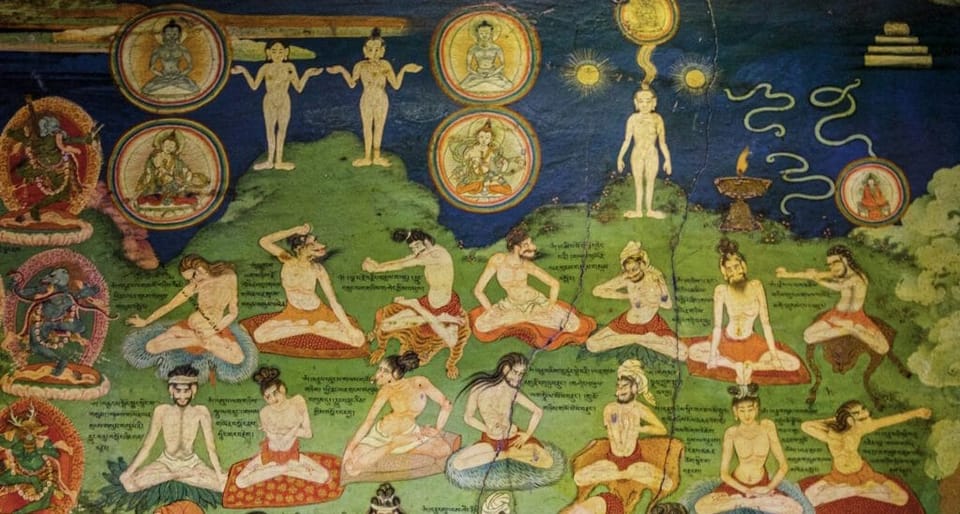Tantra & The Yoga Paths to Union: From Practice to Embodiment

Here's an outline of the major yoga traditions and how they culminate in the integrative approach of tantra—the union of all yogic paths both on and off the mat.
Traditional Paths of Yoga
Hatha Yoga
- Focus: Physical postures and breath control
- Purpose: Purification and strengthening of the body as a temple for spiritual awakening
- Key practices: Asanas (postures), pranayama (breath control), kriyas (cleansing techniques)
- Off the mat: Bringing awareness to physical sensations, honoring the body's wisdom, maintaining physical vitality
Raja Yoga
- Focus: Mental discipline and meditation
- Purpose: Control of thought waves for ultimate concentration
- Key practices: The eight limbs of yoga outlined in Patanjali's Yoga Sutras (yama, niyama, asana, pranayama, pratyahara, dharana, dhyana, samadhi)
- Off the mat: Moment-to-moment mindfulness, ethical living, self-observation
Jnana Yoga
- Focus: Intellectual inquiry and wisdom
- Purpose: Liberation through knowledge and discrimination between real and unreal
- Key practices: Self-inquiry, study of sacred texts, contemplation, questioning
- Off the mat: Discernment in daily life, seeing beyond illusions, questioning assumptions
Bhakti Yoga
- Focus: Devotion and surrender
- Purpose: Union with the divine through love and devotion
- Key practices: Chanting, prayer, ritual, worship, surrender
- Off the mat: Seeing the divine in all beings, practicing gratitude, cultivating selfless love
Karma Yoga
- Focus: Selfless service
- Purpose: Liberation through detached action
- Key practices: Serving others without attachment to results
- Off the mat: Performing all actions as offerings, working without ego attachment
Mantra Yoga
- Focus: Sacred sound
- Purpose: Transformation through vibration
- Key practices: Japa (repetition of mantras), kirtan (devotional singing)
- Off the mat: Mindfulness of speech, using sound as healing, attuning to subtle vibrations
Kundalini Yoga
- Focus: Awakening dormant energy
- Purpose: Rising of consciousness through energy centers
- Key practices: Specific kriyas, breath work, and meditations to activate kundalini energy
- Off the mat: Energy awareness, conscious evolution, transmutation of vital forces
Tantra as the Integrative Path
The Tantric Synthesis
- Definition: Tantra (meaning "to weave" or "to expand") is the comprehensive yogic approach that weaves together all other paths
- Distinctive feature: Embraces the totality of existence as divine rather than rejecting any aspect
- Core principle: Non-dualism—seeing sacred and mundane as one
Key Aspects of the Tantric Approach
1. Embodiment of All Yogas
- Incorporates physical practices (Hatha)
- Embraces meditation and mind control (Raja)
- Values wisdom and discrimination (Jnana)
- Cultivates devotion and surrender (Bhakti)
- Practices selfless service (Karma)
- Utilizes sacred sound (Mantra)
- Works with subtle energy (Kundalini)
2. Unique Tantric Elements
- Sacred outlook: Seeing divinity in everything
- Use of desire: Transforming rather than transcending desires
- Ritual and symbolism: Employing external practices to affect internal states
- Honoring of feminine: Recognizing Shakti as the active principle of consciousness
- Energy work: Sophisticated practices with subtle forces
3. Living Tantra Off the Mat
- Conscious relationship: Partners as divine reflections
- Sacred sexuality: Intimate connection as spiritual practice
- Mindful consumption: Eating, drinking, and sensory experiences as communion
- Ritual living: Infusing ordinary activities with sacred intention
- Emotional alchemy: Transforming all emotional states into fuel for awakening
Tantra in Partnership
- Sacred mirror: Partners reflecting each other's divinity and shadow
- Energy exchange: Conscious sharing and circulation of vital forces
- Polarity practice: Honoring and harmonizing masculine and feminine principles
- Transcendence through immanence: Finding the boundless through deep presence
- Co-creation: Building a shared field that amplifies individual practice
The Path of Living Yoga
Daily Integration Practices
- Morning sadhana (spiritual practice)
- Mindful transitions between activities
- Sacred pauses throughout the day
- Evening reflection and integration
- Relationship as continuous practice
Signs of Embodied Yoga
- Presence in ordinary moments
- Equanimity during challenges
- Compassionate response to suffering
- Playfulness and joy amid seriousness
- Recognition of the divine in all encounters
The Ultimate Goal
- Not an end state: Continuous unfolding and deepening
- Both personal and universal: Individual liberation that ripples outward
- Union beyond duality: Experience of non-separation while honoring the play of form
- Liberation in life: Freedom within embodiment, not escape from it
In true tantric understanding, the goal is not to reach an endpoint but to recognize that yoga (union) is our natural state—we are simply removing the veils that obscure this recognition. The path becomes the goal as we learn to live each moment as an expression of union, whether alone or with a partner, whether in meditation or in the marketplace, whether in ecstasy or in challenge.
